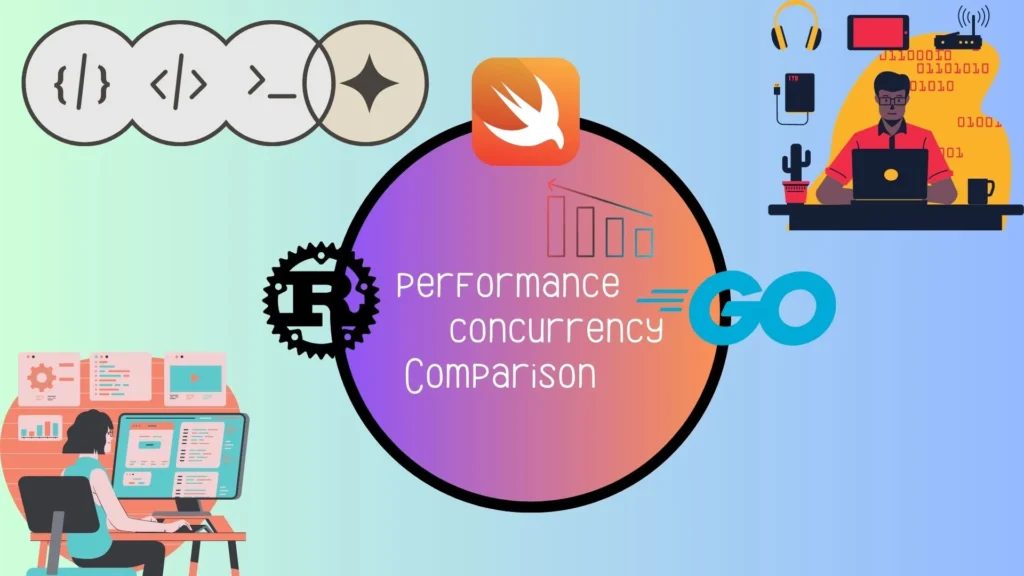Rust vs Go vs Swift: Which Language Reigns Supreme in Performance and Concurrency?

Performance and concurrency are two critical factors that developers consider when choosing a programming language for their projects. Among the languages that are currently gaining popularity in this regard are Rust, Go, and Swift. These languages are designed to offer high performance and efficient concurrency, making them ideal for building modern applications that require speed and scalability. In this article, we will explore the differences between Rust, Go, and Swift in terms of performance and concurrency, and help you decide which language to use for your next project.
Introduction
Before we dive into the differences between Rust, Go, and Swift, let’s first define what we mean by performance and concurrency.
Performance refers to how fast a program can execute its tasks. It depends on various factors, such as the language’s syntax, the compiler, the hardware it runs on, and the algorithms used in the program.
Concurrency, on the other hand, refers to a program’s ability to handle multiple tasks simultaneously. It is particularly important for applications that require a high level of responsiveness and scalability. A concurrent program can execute multiple tasks at the same time, either by running them on separate threads or by using non-blocking I/O operations.
Now that we have defined performance and concurrency, let’s move on to the languages themselves.
Rust
Rust is a systems programming language that is designed to be fast, safe, and concurrent. It was created by Mozilla and released to the public in 2010. Rust’s syntax is similar to that of C++ and it is aimed at low-level programming tasks, such as system programming, game development, and network programming.
Rust’s performance is impressive. It is a compiled language that produces fast and efficient machine code. Rust’s compiler uses the LLVM infrastructure, which optimizes the code for the target architecture. Additionally, Rust’s ownership and borrowing system ensures that memory is managed efficiently, without any runtime overhead.
Rust’s concurrency model is based on the actor model, which means that concurrency is achieved through message passing. Rust’s standard library provides a powerful concurrency library called std::sync, which includes several synchronization primitives, such as mutexes, semaphores, and channels.
Here’s an example of how Rust handles concurrency:
use std::thread;
use std::sync::{Arc, Mutex};
fn main() {
let data = Arc::new(Mutex::new(0));
let mut handles = vec![];
for i in 0..10 {
let data = data.clone();
let handle = thread::spawn(move || {
let mut data = data.lock().unwrap();
*data += i;
});
handles.push(handle);
}
for handle in handles {
handle.join().unwrap();
}
println!("Result: {:?}", data);
}
In this example, we create a shared data variable using Arc and Mutex, which allows multiple threads to access and modify the data safely. We then spawn ten threads that increment the value of the data variable by their respective index. Finally, we join the threads and print the result.
Go
Go is a modern programming language that is designed to be simple, fast, and concurrent. It was created by Google in 2009 and has gained popularity due to its ease of use and its ability to handle concurrent programming tasks.
Go’s performance is comparable to that of Rust. It is a compiled language that produces efficient machine code. Go’s compiler includes an optimizing compiler that optimizes the code for the target architecture. Additionally, Go’s garbage collector manages memory efficiently, without causing any significant runtime overhead.
Go’s concurrency model is based on goroutines and channels. Goroutines are lightweight threads that can be created easily and managed efficiently. Channels are used for communication between goroutines, allowing them to pass data and synchronize their execution.
Here’s an example of how Go handles concurrency:
package main
import (
"fmt"
"sync"
)
func main() {
var wg sync.WaitGroup
data := make(chan int)
for i := 0; i < 10; i++ {
wg.Add(1)
go func(i int) {
defer wg.Done()
data <- i
}(i)
}
go func() {
wg.Wait()
close(data)
}()
result := 0
for d := range data {
result += d
}
fmt.Printf("Result: %d\n", result)
}
In this example, we create a data channel that allows multiple goroutines to pass integers to a single receiver. We then spawn ten goroutines, each of which sends its respective index to the data channel. We use a sync.WaitGroup to wait for all the goroutines to complete, and then close the data channel. Finally, we iterate over the data channel and sum up its values.
Swift
Swift is a modern programming language that is designed to be fast, safe, and expressive. It was created by Apple in 2014 and is primarily used for developing iOS, macOS, and watchOS applications. Swift’s syntax is similar to that of Objective-C, but it is much easier to read and write.
Swift’s performance is comparable to that of Rust and Go. It is a compiled language that produces efficient machine code. Swift’s compiler includes an optimizing compiler that optimizes the code for the target architecture. Additionally, Swift’s automatic reference counting (ARC) manages memory efficiently, without causing any significant runtime overhead.
Swift’s concurrency model is based on async/await and actors. Async/await allows developers to write asynchronous code in a synchronous style, making it easier to read and write. Actors are used for managing concurrent access to shared resources, ensuring that they are accessed safely and efficiently.
Here’s an example of how Swift handles concurrency:
import Foundation
func increment(_ value: inout Int) async {
value += 1
}
func main() async {
var data = 0
await withTaskGroup(of: Void.self) { group in
for i in 0..<10 {
group.addTask {
await increment(&data)
}
}
}
print("Result: \(data)")
}
await main()
In this example, we define an increment function that increments an integer value. We then define a main function that creates a shared data variable and uses withTaskGroup to spawn ten tasks that increment the data variable. Finally, we print the result.
Additionally, the performance and concurrency characteristics of each language can vary depending on the specific use case and hardware environment. For example, a Rust program may perform differently on a system with a different processor architecture, or a Go program may behave differently when running on a multi-core CPU versus a single-core CPU.
Furthermore, this article only covers the basics of concurrency in each language, and does not delve into advanced topics such as lock-free programming or parallel algorithms.
Final Word
Rust, Go, and Swift are all excellent choices for developing high-performance and concurrent applications. Rust is best suited for low-level programming tasks that require direct memory access and high performance. Go is best suited for developing network services and web applications that require high concurrency and fast I/O. Swift is best suited for developing iOS, macOS, and watchOS applications that require high performance and elegant syntax.
Ultimately, the choice between Rust, Go, and Swift depends on your specific use case and personal preference. We hope that this article has helped you understand the differences between these languages and choose the right one for your next project.
